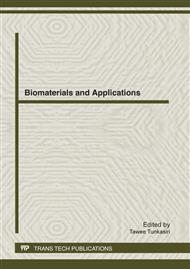p.477
p.481
p.485
p.489
p.493
p.497
p.501
p.505
p.509
Fabrication of Dental Ceramics from Silicon Nitride Core with Borosilicate Glass Veneer
Abstract:
Silicon nitride ceramic is a potential material for clinical indications due to its high fracture toughness, strength, and non-cytotoxicity. For this reason, Si3N4 ceramic is interested to apply for dental core. The superiority of Si3N4 ceramic is the low coefficient of thermal expansion (CTE) which is lower than that of zirconia and alumina ceramics that are popular in this field. In this study, borosilicate glass powder with 5 wt% of zirconia addition was prepared by melting at 1450 °C for 1 h. The glass melt was quenched and was then ground to be a powder and mixed with polyvinyl alcohol solution to be a paste. The Si3N4 specimens coated with the veneer were fired in electrical tubular furnace at 1100 °C for 15 min. The appearance of these specimens shows smooth, glossy without defect and crazing. The veneer has thermal expansion coefficient as 3.05x10-6 °C-1 and the Vickers hardness as 4.0 GPa which is close to the human teeth. The specimens were tested by human gingival and periodontal ligament fibroblasts (HGF and HPDLF) and cytotoxicity by MTT assay. The results indicated that Si3N4 ceramic and borosilicate glass can be used as dental materials.
Info:
Periodical:
Pages:
493-496
Citation:
Online since:
April 2012
Price:
Сopyright:
© 2012 Trans Tech Publications Ltd. All Rights Reserved
Share:
Citation:


